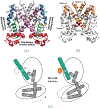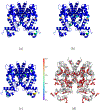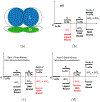Molecular Dynamics Simulations Establish the Molecular Basis for the Broad Allostery Hotspot Distributions in the Tetracycline Repressor
- PMID: 35675441
- PMCID: PMC9616627
- DOI: 10.1021/jacs.2c03275
Molecular Dynamics Simulations Establish the Molecular Basis for the Broad Allostery Hotspot Distributions in the Tetracycline Repressor
Abstract
It is imperative to identify the network of residues essential to the allosteric coupling for the purpose of rationally engineering allostery in proteins. Deep mutational scanning analysis has emerged as a function-centric approach for identifying such allostery hotspots in a comprehensive and unbiased fashion, leading to observations that challenge our understanding of allostery at the molecular level. Specifically, a recent deep mutational scanning study of the tetracycline repressor (TetR) revealed an unexpectedly broad distribution of allostery hotspots throughout the protein structure. Using extensive molecular dynamics simulations (up to 50 μs) and free energy computations, we establish the molecular and energetic basis for the strong anticooperativity between the ligand and DNA binding sites. The computed free energy landscapes in different ligation states illustrate that allostery in TetR is well described by a conformational selection model, in which the apo state samples a broad set of conformations, and specific ones are selectively stabilized by either ligand or DNA binding. By examining a range of structural and dynamic properties of residues at both local and global scales, we observe that various analyses capture different subsets of experimentally identified hotspots, suggesting that these residues modulate allostery in distinct ways. These results motivate the development of a thermodynamic model that qualitatively explains the broad distribution of hotspot residues and their distinct features in molecular dynamics simulations. The multifaceted strategy that we establish here for hotspot evaluations and our insights into their mechanistic contributions are useful for modulating protein allostery in mechanistic and engineering studies.
Figures









Similar articles
-
Identification and understanding of allostery hotspots in proteins: Integration of deep mutational scanning and multi-faceted computational analyses.J Mol Biol. 2025 Feb 12:168998. doi: 10.1016/j.jmb.2025.168998. Online ahead of print. J Mol Biol. 2025. PMID: 39952349 Review.
-
Modulation of Allostery with Multiple Mechanisms by Hotspot Mutations in TetR.J Am Chem Soc. 2024 Jan 31;146(4):2757-2768. doi: 10.1021/jacs.3c12494. Epub 2024 Jan 17. J Am Chem Soc. 2024. PMID: 38231868 Free PMC article.
-
A parameterized two-domain thermodynamic model explains diverse mutational effects on protein allostery.Elife. 2024 Jun 5;12:RP92262. doi: 10.7554/eLife.92262. Elife. 2024. PMID: 38836839 Free PMC article.
-
Modulation of Allostery with Multiple Mechanisms by Hotspot Mutations in TetR.bioRxiv [Preprint]. 2023 Dec 12:2023.08.29.555381. doi: 10.1101/2023.08.29.555381. bioRxiv. 2023. Update in: J Am Chem Soc. 2024 Jan 31;146(4):2757-2768. doi: 10.1021/jacs.3c12494. PMID: 37905112 Free PMC article. Updated. Preprint.
-
Allostery in G protein-coupled receptors investigated by molecular dynamics simulations.Curr Opin Struct Biol. 2019 Apr;55:121-128. doi: 10.1016/j.sbi.2019.03.016. Epub 2019 May 13. Curr Opin Struct Biol. 2019. PMID: 31096158 Free PMC article. Review.
Cited by
-
Identification and understanding of allostery hotspots in proteins: Integration of deep mutational scanning and multi-faceted computational analyses.J Mol Biol. 2025 Feb 12:168998. doi: 10.1016/j.jmb.2025.168998. Online ahead of print. J Mol Biol. 2025. PMID: 39952349 Review.
-
Perspectives on Computational Enzyme Modeling: From Mechanisms to Design and Drug Development.ACS Omega. 2024 Feb 8;9(7):7393-7412. doi: 10.1021/acsomega.3c09084. eCollection 2024 Feb 20. ACS Omega. 2024. PMID: 38405524 Free PMC article. Review.
-
Deep mutational scanning and machine learning reveal structural and molecular rules governing allosteric hotspots in homologous proteins.Elife. 2022 Oct 13;11:e79932. doi: 10.7554/eLife.79932. Elife. 2022. PMID: 36226916 Free PMC article.
-
Molecular insights into antibiofilm inhibitors of Streptococcus mutans glucosyltransferases through in silico approaches.Sci Rep. 2025 Apr 23;15(1):14160. doi: 10.1038/s41598-025-98927-8. Sci Rep. 2025. PMID: 40269071 Free PMC article.
-
Dynamics-based protein network features accurately discriminate neutral and rheostat positions.Biophys J. 2024 Oct 15;123(20):3612-3626. doi: 10.1016/j.bpj.2024.09.013. Epub 2024 Sep 13. Biophys J. 2024. PMID: 39277794
References
-
- Monod J; Wyman J; Changeux J-P On the nature of allosteric transitions: a plausible model. J. Mol. Biol 1965, 12, 88–118. - PubMed
-
- Koshland DEJ; Nemethy G; Filmer D Comparison of experimental binding data and theoretical models in proteins containing subunits. Biochem. 1966, 5, 365–385. - PubMed
-
- Alberts B; Bray D; Lewis J; Raff M; Roberts K; Watson JD Molecular biology of the cell; Garland Publishing, Inc., 1994.
-
- Changeux J-P; Edelstein SJ Allosteric mechanisms of signal transduction. Science 2005, 308, 1424–1428. - PubMed
Publication types
MeSH terms
Substances
Grants and funding
LinkOut - more resources
Full Text Sources

